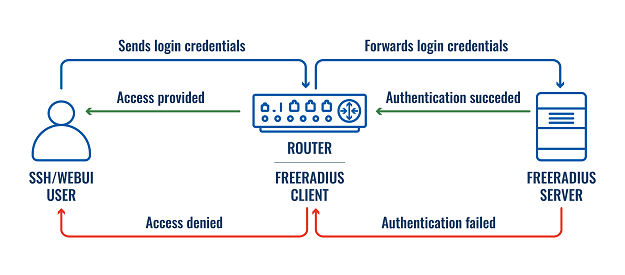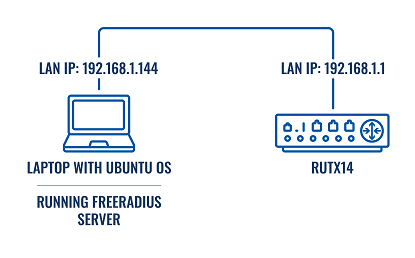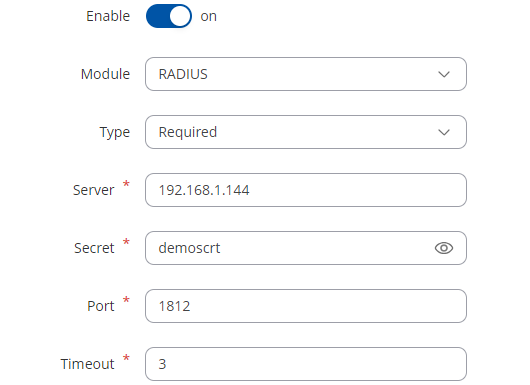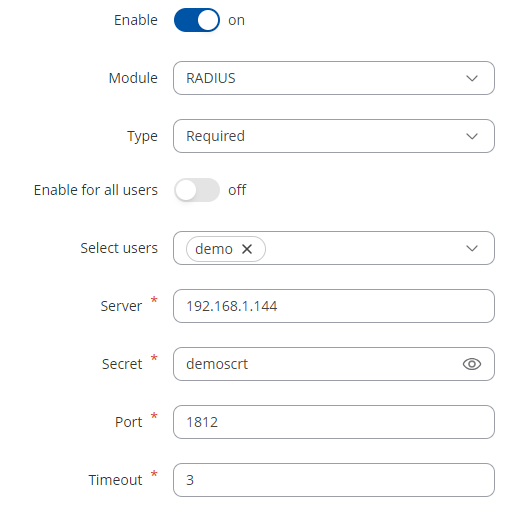Setting up external Radius server for RUTOS authentication: Difference between revisions
No edit summary |
TautvydasV (talk | contribs) mNo edit summary |
||
| (6 intermediate revisions by one other user not shown) | |||
| Line 1: | Line 1: | ||
==Summary== | ==Summary== | ||
In this example | In this example we will perform a basic Radius server configuration for router's SSH and WebUI authentication. We will use the ''freeradius'' package to set up a local Radius server on an Ubuntu virtual machine. Lastly, we will test the configuration. | ||
This is the idea of how a Radius server is used for RUTOS authentication:<br> | This is the idea of how a Radius server is used for RUTOS authentication:<br> | ||
[[File:Networking freeradius lan principle diagram v1.png|border|class=tlt-border]] | [[File:Networking freeradius lan principle diagram v1.png|border|class=tlt-border]] | ||
==Topology used in this example== | ==Topology used in this example== | ||
[[File:Networking freeradius lan topology diagram v1.png|border | [[File:Networking freeradius lan topology diagram v1.png|border|class=tlt-border]] | ||
==Prerequisites== | ==Prerequisites== | ||
*'''Router''' with the ability to install | *'''Router''' with the ability to install an additional package - PAM | ||
*'''Ubuntu machine''' with the ability to host a local FreeRadius server | *'''Ubuntu machine''' with the ability to host a local FreeRadius server | ||
==Preparing Ubuntu machine== | ==Preparing Ubuntu machine== | ||
====Installing the FreeRadius server==== | ====Installing the FreeRadius server==== | ||
Firstly, update the package | Firstly, update the package list and upgrade the packages to their latest version: | ||
sudo apt update | sudo apt update | ||
sudo apt upgrade | sudo apt upgrade | ||
| Line 19: | Line 17: | ||
Next, install the FreeRadius package: | Next, install the FreeRadius package: | ||
sudo apt install freeradius | sudo apt install freeradius | ||
====Defining a | ====Defining a Client==== | ||
Client - a router that will use FreeRadius to authenticate WebUI and/or SSH users. | Client - a router that will use FreeRadius to authenticate WebUI and/or SSH users. | ||
In order to add/edit clients, we need to access the '''clients.conf''' file. Use your favorite text editor to edit it: | In order to add/edit clients, we need to access the '''clients.conf''' file. Use your favorite text editor to edit it: | ||
sudo nano /etc/freeradius/3.0/clients.conf | sudo nano /etc/freeradius/3.0/clients.conf | ||
For this example | |||
For this example we will add the following lines in order to accept any IP address as a client: | |||
client 0.0.0.0/0 { | client 0.0.0.0/0 { | ||
secret = demoscrt | secret = demoscrt | ||
| Line 31: | Line 30: | ||
'''Note:''' a specific public IP of the client can be used instead of 0.0.0.0/0 | '''Note:''' a specific public IP of the client can be used instead of 0.0.0.0/0 | ||
====Defining user login credentials==== | ====Defining user login credentials==== | ||
Before we create | Before we create a user's login credentials, let's create an MD5 hash and use it instead of a clear text password. We will generate a hash value of '''demo123''' using the following command: | ||
echo -n | echo -n demo123| md5sum | awk '{print $1}' | ||
We will now define credentials for user '''demo'''. Use your favorite text editor to edit the file '''users''': | We will now define credentials for user '''demo'''. Use your favorite text editor to edit the file '''users''': | ||
| Line 38: | Line 37: | ||
Add the name of the user, MD5 hash value of its password, and a reply message: | Add the name of the user, MD5 hash value of its password, and a reply message: | ||
demo MD5-Password:= " | demo MD5-Password:= "62cc2d8b4bf2d8728120d052163a77df" | ||
Reply-Message := "Hello, %{User-Name}" | Reply-Message := "Hello, %{User-Name}" | ||
| Line 44: | Line 43: | ||
sudo /etc/init.d/freeradius start | sudo /etc/init.d/freeradius start | ||
==Preparing router== | ==Preparing router== | ||
Firstly, | ===Creating a static IP lease for FreeRadius server=== | ||
* | Firstly, we will set a static IP lease for the Ubuntu machine running FreeRadius server. To do that you can use two methods. | ||
====First method==== | |||
* Connect to the WebUI | |||
* Navigate to '''Status → Network → LAN''' | |||
[[File:Networking | * In the '''DHCP Leases section''' you should add Ubuntu machine's IP address | ||
* Press [[File:Networking create static button from DHCP leases section v1.png]] near the instance to create a static IP lease | |||
====Second method==== | |||
* Connect to the WebUI | |||
* Navigate to '''Network → DHCP → Static Leases''' | |||
* Add the Ubuntu machine's MAC, IP, and provide a description | |||
[[File:Networking add static lease fw76 v1.png|border|class=tlt-border]] | |||
* Press [[File:Networking save apply button fw76 v1.png]] | |||
===Creating a new RUTOS user=== | ===Creating a new RUTOS user=== | ||
Now we will need to create a new user for SSH and/or WebUI access. To do that follow these steps: | Now we will need to create a new user for SSH and/or WebUI access. To do that follow these steps: | ||
* Go to '''System → Administration → User Settings → System Users''' section | * Go to '''System → Administration → User Settings → System Users''' section | ||
* In the Add new user section fill | * In the Add new user section fill the user's login credentials. | ||
You can specify your own custom role or choose one from the default roles. In this example, | You can specify your own custom role or choose one from the default roles. In this example, admin role was chosen.<br> | ||
[[File:Networking | [[File:Networking new device user fw76 v1.png|border|class=tlt-border]]<br> | ||
'''Remember:''' use the '''same username as in''' FreeRadius '''users''' file. The password can be different, compared to the one in FreeRadius '''users''' file. | '''Remember:''' use the '''same username as in''' FreeRadius '''users''' file. The password can be different, compared to the one in FreeRadius '''users''' file. | ||
===PAM package installation=== | ===PAM package installation=== | ||
Now we will need to install a PAM package, to do that follow these steps: | Now we will need to install a PAM package, to do that follow these steps: | ||
* Go to '''System → Package Manager → Packages''' | * Go to '''System → Package Manager → Packages''' | ||
* '''Install''' the '''PAM''' package | |||
===Radius server configuration=== | ===Radius server configuration=== | ||
Now we will set the FreeRadius server's information on the router | Now we will set the FreeRadius server's information on the router | ||
====For SSH authentication==== | ====For SSH authentication==== | ||
Firstly we will need to enable SSH access for the created user. To do that, follow these steps: | |||
* Go to '''System → Administration → User Settings → System Users''' section | |||
* Press [[File:Networking edit button fw76 v1.png]] near the newly created user | |||
* '''Enable''' the '''SSH access''' | |||
* Press [[File:Networking save apply button fw76 v1.png]] | |||
To enable PAM authentication for SSH, follow these steps: | To enable PAM authentication for SSH, follow these steps: | ||
* Go to '''System → Administration → Access Control → PAM''' section | * Go to '''System → Administration → Access Control → PAM''' section | ||
* Press [[File:Networking edit button fw76 v1.png]] near the SSH instance | * Press [[File:Networking edit button fw76 v1.png]] near the SSH instance | ||
* '''Enable''' the '''instance''' | |||
* Set '''module''' to '''RADIUS''' | |||
* Set '''type''' to '''Required''' | |||
* Set '''server''' to '''Ubuntu machine's IP''' | |||
* Set '''secret''' to '''the one defined in''' the FreeRadius '''clients.conf''' file | |||
* Leave '''Port''' and '''Timeout''' to their '''default''' values | * Leave '''Port''' and '''Timeout''' to their '''default''' values | ||
[[File:Networking pam ssh freeradius config fw76 | [[File:Networking pam ssh freeradius config fw76 v1.png|border|class=tlt-border]] | ||
* Press [[File:Networking save apply button fw76 v1.png]] | * Press [[File:Networking save apply button fw76 v1.png]] | ||
====For WebUI authentication==== | ====For WebUI authentication==== | ||
To enable PAM authentication for WebUI, follow these steps: | To enable PAM authentication for WebUI, follow these steps: | ||
* Go to '''System → Administration → Access Control → PAM''' section | * Go to '''System → Administration → Access Control → PAM''' section | ||
* Press [[File:Networking edit button fw76 v1.png]] near the | * Press [[File:Networking edit button fw76 v1.png]] near the SSH instance | ||
* '''Enable''' the '''instance''' | |||
* Set '''module''' to '''RADIUS''' | |||
* In the '''Select users add '''the newly created '''user or enable''' PAM authentication '''for all users''' | |||
* Set '''type''' to '''Required''' | |||
* Set '''server''' to '''Ubuntu machine's IP''' | |||
* Set '''secret''' to '''the one defined in''' the FreeRadius '''clients.conf''' file | |||
* Leave '''Port''' and '''Timeout''' to their '''default''' values | * Leave '''Port''' and '''Timeout''' to their '''default''' values | ||
[[File:Networking pam webui freeradius config fw76 | [[File:Networking pam webui freeradius config fw76 v1.png|border|class=tlt-border]] | ||
* Press [[File:Networking save apply button fw76 v1.png]] | * Press [[File:Networking save apply button fw76 v1.png]] | ||
==Testing configuration== | ==Testing configuration== | ||
| Line 116: | Line 124: | ||
[pap] = reject | [pap] = reject | ||
} # Auth-Type PAP = reject | } # Auth-Type PAP = reject | ||
Revision as of 15:51, 27 November 2023
Main Page > General Information > Configuration Examples > Router control and monitoring > Setting up external Radius server for RUTOS authenticationSummary
In this example we will perform a basic Radius server configuration for router's SSH and WebUI authentication. We will use the freeradius package to set up a local Radius server on an Ubuntu virtual machine. Lastly, we will test the configuration.
This is the idea of how a Radius server is used for RUTOS authentication:

Topology used in this example
Prerequisites
- Router with the ability to install an additional package - PAM
- Ubuntu machine with the ability to host a local FreeRadius server
Preparing Ubuntu machine
Installing the FreeRadius server
Firstly, update the package list and upgrade the packages to their latest version:
sudo apt update sudo apt upgrade
Next, install the FreeRadius package:
sudo apt install freeradius
Defining a Client
Client - a router that will use FreeRadius to authenticate WebUI and/or SSH users. In order to add/edit clients, we need to access the clients.conf file. Use your favorite text editor to edit it:
sudo nano /etc/freeradius/3.0/clients.conf
For this example we will add the following lines in order to accept any IP address as a client:
client 0.0.0.0/0 {
secret = demoscrt
shortname = 0.0.0.0/0
}
Note: a specific public IP of the client can be used instead of 0.0.0.0/0
Defining user login credentials
Before we create a user's login credentials, let's create an MD5 hash and use it instead of a clear text password. We will generate a hash value of demo123 using the following command:
echo -n demo123| md5sum | awk '{print $1}'
We will now define credentials for user demo. Use your favorite text editor to edit the file users:
sudo nano /etc/freeradius/3.0/users
Add the name of the user, MD5 hash value of its password, and a reply message:
demo MD5-Password:= "62cc2d8b4bf2d8728120d052163a77df"
Reply-Message := "Hello, %{User-Name}"
Once these changes are made, start the FreeRadius service:
sudo /etc/init.d/freeradius start
Preparing router
Creating a static IP lease for FreeRadius server
Firstly, we will set a static IP lease for the Ubuntu machine running FreeRadius server. To do that you can use two methods.
First method
- Connect to the WebUI
- Navigate to Status → Network → LAN
- In the DHCP Leases section you should add Ubuntu machine's IP address
- Press
 near the instance to create a static IP lease
near the instance to create a static IP lease
Second method
- Connect to the WebUI
- Navigate to Network → DHCP → Static Leases
- Add the Ubuntu machine's MAC, IP, and provide a description
Creating a new RUTOS user
Now we will need to create a new user for SSH and/or WebUI access. To do that follow these steps:
- Go to System → Administration → User Settings → System Users section
- In the Add new user section fill the user's login credentials.
You can specify your own custom role or choose one from the default roles. In this example, admin role was chosen.
File:Networking new device user fw76 v1.png
Remember: use the same username as in FreeRadius users file. The password can be different, compared to the one in FreeRadius users file.
PAM package installation
Now we will need to install a PAM package, to do that follow these steps:
- Go to System → Package Manager → Packages
- Install the PAM package
Radius server configuration
Now we will set the FreeRadius server's information on the router
For SSH authentication
Firstly we will need to enable SSH access for the created user. To do that, follow these steps:
- Go to System → Administration → User Settings → System Users section
- Press
 near the newly created user
near the newly created user - Enable the SSH access
- Press

To enable PAM authentication for SSH, follow these steps:
- Go to System → Administration → Access Control → PAM section
- Press
 near the SSH instance
near the SSH instance - Enable the instance
- Set module to RADIUS
- Set type to Required
- Set server to Ubuntu machine's IP
- Set secret to the one defined in the FreeRadius clients.conf file
- Leave Port and Timeout to their default values
For WebUI authentication
To enable PAM authentication for WebUI, follow these steps:
- Go to System → Administration → Access Control → PAM section
- Press
 near the SSH instance
near the SSH instance - Enable the instance
- Set module to RADIUS
- In the Select users add the newly created user or enable PAM authentication for all users
- Set type to Required
- Set server to Ubuntu machine's IP
- Set secret to the one defined in the FreeRadius clients.conf file
- Leave Port and Timeout to their default values
Testing configuration
Now that we have the setup configured, we can test if the server properly authenticates the user. To see authentication requests on the FreeRadius server side, follow these steps:
- Stop the FreeRadius service using this command:
sudo /etc/init.d/freeradius stop
- Start the FreeRadius server in debug mode using this command:
sudo freeradius -X
- Try connecting to the router's WebUI and/or SSH service
If the authentication is successful the server logs will contain these lines:
Auth-Type PAP {
pap: Login attempt with password
pap: Comparing with "known-good" MD5-Password
pap: User authenticated successfully
[pap] = ok
} # Auth-Type PAP = ok
If the authentication is unsuccessful the server logs will contain these lines:
Auth-Type PAP {
pap: Login attempt with password
pap: Comparing with "known-good" MD5-Password
pap: ERROR: MD5 digest does not match "known good" digest
pap: Passwords don't match
[pap] = reject
} # Auth-Type PAP = reject




